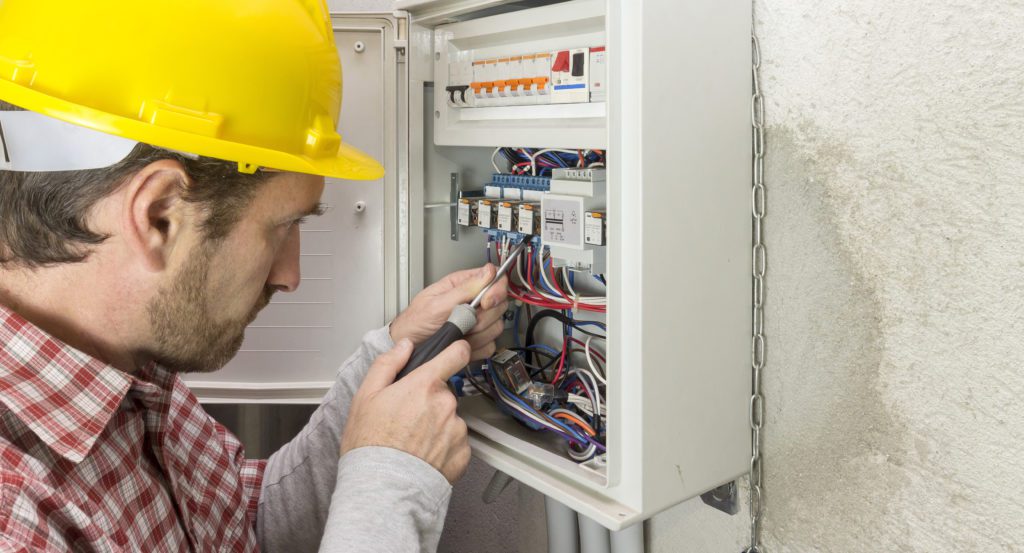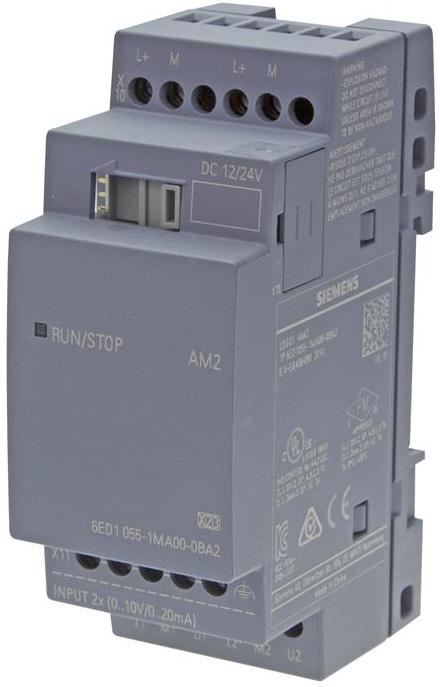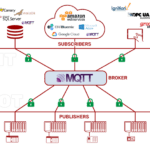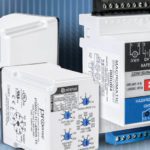 Top design objectives for control installations include capability, reliability, and cost effectiveness. Many new and retrofitted control panels employ components such as PLCs and even industrial PCs (IPCs) and programmable automation controllers (PACs) for advanced connectivity and control. It’s often appropriate to use these more complicated (and capable) options and remove or forgo electromechanical relays in the system. In other cases, machines that have simple architectures, fixed functions, or specialty requirements may derive benefit from connectivity and control primarily based on electromechanical relays and SSRs.
Top design objectives for control installations include capability, reliability, and cost effectiveness. Many new and retrofitted control panels employ components such as PLCs and even industrial PCs (IPCs) and programmable automation controllers (PACs) for advanced connectivity and control. It’s often appropriate to use these more complicated (and capable) options and remove or forgo electromechanical relays in the system. In other cases, machines that have simple architectures, fixed functions, or specialty requirements may derive benefit from connectivity and control primarily based on electromechanical relays and SSRs.
In still other cases, hybrid approaches are best — to combine various technology types and leverage the benefits of today’s controls and relays.
Let’s consider the parameters that can factor into this engineering decision.
Where relays are the suitable choice
Relays are an enduring technology that is simple and efficient — and relay-based control excels at satisfying very specific design requirements. Oftentimes plant personnel and end users are familiar with or prefer their inclusion, and most industrial technicians can install them without issue. That’s in contrast with other control options, which necessitate preconfiguration and advanced programming for proper commissioning.

Applications needing little troubleshooting of wired logic benefit from the use of traditional relays as a cost-effective choice. Simple diagnostics are possible with electromechanical relays sporting indicator LEDs (communicating the coil’s electrical status) and mechanical flags (communicating contact status) for unambiguous information about the device. But elsewhere, advanced relays include diagnostics as well as communications with microprocessing power and the ability to connect to software via comas they’re particularly useful in arrangements where relays interface with motors needing protection against the effects of ground faults, overloads, and other situations that can damage windings.
Further facilitating their application is the increasing convenience of ever-smaller relay footprints for both electromechanical relays and SSRs already discussed. Relay-design advances with optimized circuitry, efficiency, and heatsinks mean today’s relays are much smaller than previous generations with the same mA or A switch rating. Even relays having the ice-cube format have in recent years seen advancement with embedded processing.

These increasingly compact form factors of smart relays complement their expanded functions. As mentioned in an article on DIN rail, many such relays are now manufactured in 6-mm slice geometry for DIN-rail mounting, which (besides saving space) also eliminates the need for daisy-chain wiring schemes. In some instances, power bridges (to power multiple relays) further simplify and ruggedize their installation. Another development for simpler relays are increasingly standardized sockets that accept insertion of relays and timers with various pole counts and voltage requirements.

Relays can unburden safety PLCs of alarm and response tasks, which is helpful where programming even modest design changes is a hassle. In fact, smart relays can be more suitable than certain controls on otherwise simple designs needing safety functions — for example, where safety PLCs are prohibitively expensive. The economy of relays (especially on designs needing only a few safety points) can allow safety functionalities that might otherwise be omitted. Here, single-channel relays and smart alarms are top choices for safety sans overcomplicated implementations.
Where smart relays are configurable and assume safety functions (going beyond redundant electrical connections with processing capabilities) they’ve come to closely resemble small safety PLCs. Such configurable relays can have slightly less logic and configurability than PLCs but require less technician knowhow and software for programming.

• Cyclic equal on first and pulse output — 500 msec fixed
• Delay on break and delay on make or break
• Interval after break and single shot
• Re-triggerable single shot and latching relay
• Relay on break with totalize
• Interval with totalize.
In fact, several protective relays on the market today include data-processing power as well as advanced communications. These and other smart relays can include EtherNet/IP, CANopen, PROFIBUS, and other protocol communications for the transmission of data about relay-monitored devices.

IO-Link connectivity has had perhaps the most adoption in relays for monitoring functions … especially of single and three-phase voltage sources. IO-Link-ready relays impart continual access to variables as well as signal scaling — in the past something only possible with PLCs and higher-level controls. In short, signal scaling allows inbound and outbound relay communications for the output of system values and the input of new setpoints. Read more about the spread of IO-Link here and here.
Other configurable relays accepting SIM cards are capable of cellular communications to support M2M functions in remote settings. Such smart relays can transmit instructions and receive alerts even without a wireless network.
Where PLCs are the suitable choice
Controls that take the form of PLCs or incorporate PLC functionalities continue to proliferate in operations needing coordinated system automation. PLCs also excel where logic functions must accommodate reconfigurable equipment — as for machinery involved in producing batch sizes down to one. Such controllers store in memory instantly accessible alternative routines. Case in point: New models of electric vehicles are released every year — requiring annual production-line retooling. Relay-based logic would necessitate physical rewiring and the addition of relay modules to make such changes. That’s no issue where onsite personnel is familiar with the design (and may be fastest in some instances) but with no such technicians, PLCs and higher controls accept software-based parametric updates for quick turnaround of new automation routines.

Many PLCs can also handle arrays of I/O nodes and the addition of high-density digital I/O to minimize control-rack size. PLCs impart diagnostic functions to identify failed I/O points requiring replacement — impossible with legacy relays. Plus add-on PLC cards can satisfy the need to supplement with devices exceeding the voltage and current ratings of existing I/O … and options abound to address field-device reactivity.

PLCs have also become increasingly cost-effective — in some instances becoming cost-competitive with relay-socket-connector setups of comparable capabilities. That’s in large part because the cost of installation for the latter and the efforts of a technician required to hardwire relay-based systems.
Though we’ve touched on how some particularly capable smart relays are practically indistinguishable from simple PLCs, some relay logic is limited to simple Boolean control. So where designs go beyond very specific tasks, traditional relays at least necessitate the addition of counters and timing relays— and may not be able to execute all diagnostics required to keep an installation optimized. In contrast, even simple PLCs are capable of counting, timing, and diagnostics — as well as accepting reprogramming for applications that change.
PLCs also facilitate the addition of HMIs for human-readable communication of cycle counts, system status, and faults. With PLCs now allowing technicians more accessibility (with laptops and smartphones) their use has become practical for more applications. In fact, today’s most advanced controls can collect and analyze production floor data (as well as distilled data from edge devices with built-in processors) for full IIoT connectivity.

Where relays complement other controls
We’ve covered the situations where relays excel and those for which PLCs are most suitable. But a vast array of automated installations benefit from hybrid control architectures that integrate a combination of PLCs and relays —electromechanical relays and SSRs.
For example, PLCs benefit from the help of relays to switch and control high-current devices. After all, PLCs excel in commanding small electrical loads such as contactors, annunciators, safety indicators, and relay coils of low ampacity. In contrast, advanced relays can switch larger loads of several amps and beyond — associated with electric motors, valves, linear actuators, and other components. Where a particularly inductive field device threatens to damage controls with surge or inrush current (or voltage spikes) interposing relays can (serving as a sacrificial component) complement a PLC. SSRs in particular excel at isolating and protecting controls from EMI — especially in designs that drive particularly inductive loads … and relays shield PLCs from high-voltage transients when loads are switched off. Of course, relays and PLCs used together must have electromagnetic compatibility.
Still other designs use SSRs or PLC digital output on points needing high-frequency switching because solid-state devices (with their theoretically infinite number of cycles) extend machine life in these situations. SSRs in particular are indispensable for commanding high-speed components in timing, sensing, and machine-vision functions.
During retrofits, portions of a design may accept a PLC upgrade while the rest of the installation continues to run off a relay panel. After all, replacing legacy relay systems with improved models can extend control-panel life. That may mean the swapping out of electromechanical relays with SSRs … because with automated diagnostics accessible through today’s through Ethernet-based protocols in particular, SSRs can communicate when failures do occur.
Elsewhere, relays complement various control and I/O combinations. That’s why many high-density I/O components use relays to either convert voltage or amplify current to accessible values. Relays can complement high-density low-power digital I/O on PACs for some tasks run off traditional high-current equipment. Such hybrid installations are more common for retrofits … but no matter the installation phase, PAC communications and logic often work well with relay-based systems.
PLCs can also benefit from the help of relays to convert field devices’ various voltages for signal outputs to one standard (for example, 24 Vdc) if that’s all the PLC accepts. Certain SSRs can even execute signal conditioning on these inputs if that’s required.
Other engineers pair relays and PLCs when output signals need addressing — typically around the system’s PLC where high-ampacity components that the PLC can’t handle. Some DIN-rail I/O modules are also designed to integrate with relays for safety — and relay on PLCs for the distributed control of field devices imparting IIoT functionality.
Of course, new designs for both electromechanical relays and SSRs have blurred lines between these subtypes — as well as those between SSRs and other controls. As mentioned, the most advanced programmable relays are often indistinguishable from micro PLCs for delivering configurability via ladder logic and other standard programming … so that relay logic and ladder logic aren’t mutually exclusive.







Leave a Reply
You must be logged in to post a comment.